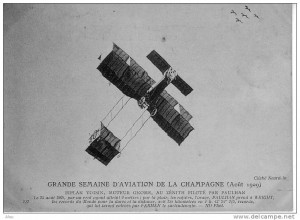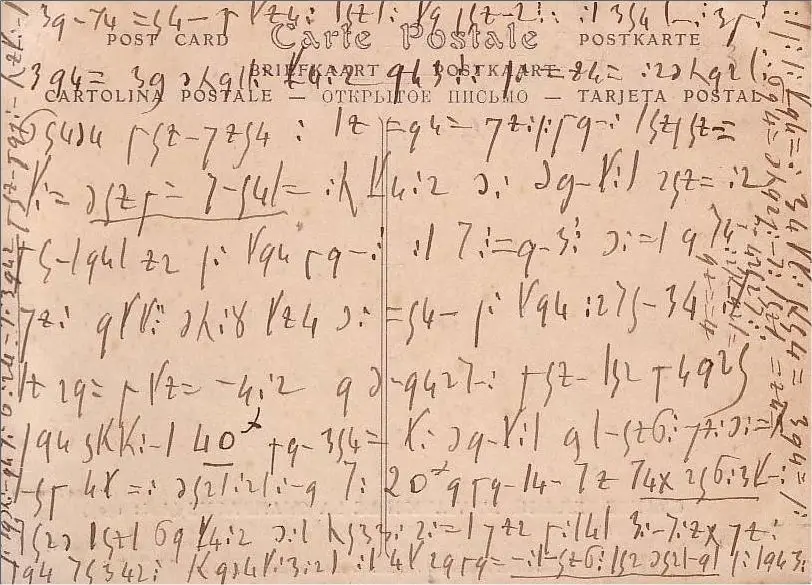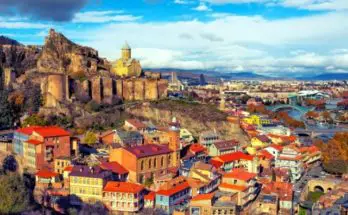We were sent an old postcard representing a plane during an air show in Reims, France, in 1909. The owner of the postcard would like to know what kind of language or code is written on the back. Can you help?
This is the front of the postcard:

Thank you for your help!




dear team;
after looking at the unknown photo that was posted to you on 13/02/2010 by postcard. i have download the image and started to decypher the letter will get back to you in due course.
in the mean time i am also having trouble with an unknown language myself i know i can read and write it but dont known were it came from.
Rather than being a language as such, it appears to be many equations. I can definitely see normal numbers, and the letters of the english language. Of course with all hand writing, the way a person writes can look completely illogical to other people.
I have worked with formulae for many years, so I feel quite confident in my answer
Thank you all for your help. Could it be equations dealing with aerodynamics, as someone else suggested in the French version of this blog?
I am an American who has lived/worked in Romania over a decade. I recognized immediately, the use of BOTH a French and Romanian “4” and “uncrossed 7” used equally, within the text.
This indicates someone, either Romanian or French, who has recently been exposed to learning the other language (and has not yet fully assimilated the newly learned language, thus unconsciously shifts from one to the other, randomly).
For two reasons, it is unlikely this person is French. First, very few Europeans at the turn of the 20th century, would have any interest or need to learn Romanian language. There was (and remains) a deep prejudice against recognizing Romanian genius, based solely on the small gypsy population there (Hungary’s gypsy percentage is twice as large!). Secondly, the postcard is from a Paris event, where the foreigner is more likely the visitor -than the local, vis-a-vis.
One will also notice there are several letters of Greek alphabet as well, most frequently “lambda”, commonly used in aerospace engineering formulas (as well as in physics, overall).
The most likely “calligraphic suspect” here is a Romanian visitor to the Paris Air show, and one with an aerospace/engineering background.
There are, indeed, two such Romanians who attended this exposition that year.
1. Henri Coanda: Henri’s attendance at the 1909 Paris airshow is documented. He is the inventor, designer and builder of the first jet engine/jet airplane (1910). After building the first airplane for the Romanian military, Henri travelled to Paris in 1909, where he enrolled in the newly founded Ecole Nationale Superieure d’Ingenieurs en Construction Aeronautique (now the Ecole Nationale Superieure de l’Aeronautique et de l’Espace, also known as SUPAERO). One year later (1910) he graduated at the head of the first class of aeronautical engineers, and soon thereafter, built (and piloted) his jet plane. He discovered the Venturi Effect and the “Coanda Effect”, both important to aerospace engineering and internal combustion/carburetion design.
2. Aurel Vlaicu: Aurel’s attendance is likely, but not documented (he was in Paris that year, but exact time is uncertain). Vlaicu was a Romanian engineer, inventor, airplane builder (3). His design was the first to have the dominant modern configuration (large wing forward, small 3-part tail aft, with virtually the same flight controls). He also designed the first monoplane. Henri died at 31, while flying over the Carpathian (Alps) mountains in one of his planes (which having crossed all but the highest peak, may hold the altitude record for his time).
Personally, I am leaning towards Coanda, who was the more “physics formula” oriented of the two. And to my recollection, having seen the writings of both men, Coanda’s fits perfectly, while Vlaicu was more prone to cursive, even in formulae. Last, Coanda is well known to use a multitude of paper scraps taken in travels (including post cards) for impromptu formula-writing and note-taking. I am not currently near the museums that house his works, so I cannot compare the handwriting, but I am certain it is within his overall style.
Dana thanks a lot for your comment, it’s just amazing that you could even narrow it down to one person or two.
This looks like a mathematical formula of some sort; like someone’s homework, or something that a mathematician or scientist was trying to work out.
I think it’s just a simple substitution code. You know – start with the most common letter of the alphabet (e) and assign that to the most used letter/symbol and so on.
It looks like some sort of enigma code
i recently looked into old English and the letters aren’t far from that! since its mostly formulas,greek letters are expected and maybe some from the home language of the writer.its OLD and CODED, thats for sure!